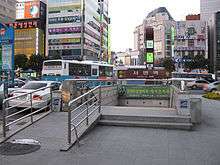Seomyeon, Busan
Seomyeon is the commercial center and transportation hub in Busanjin-gu, Busan, South Korea. Seomyeon is also the most crowded area in Busan, having an average floating population of 1,000,000 a day.[1] Seomyeon has three underground shopping malls meeting beneath the Seomyeon road junction, a department store, many shopping stores, bars, restaurants, movie theaters, banks, bookstores, clinics, etc.

Name
The area called Seomyeon is Bujeon-dong,[2] Busanjin-gu, Busan. The name of Seomyeon was that of an old administrative district surrounding the area when Busan was a small village in the Joseon Dynasty Era.[2] Current Busanians still call the area Seomyeon as then Busanians did, though its official administrative name now is Bujeon-dong.
Symbology
_by_RWD.jpg)
The district flag of Busanjin-gu symbolizes the 5-way intersection of Seomyeon. It represents the center of Busan as a hub of globalization, finance, commerce, distribution, and information. The district tree is the gingko,[3] which can be seen throughout the area and is said to symbolize stability due to the resistant nature that protects it against disease and insects. The district flower is the chrysanthemum,[3] another plant known to endure harsh conditions. The district bird is the magpie, known for building nests in the branches of very high trees.[3]
Transportation

As a transportation hub, Seomyeon has most public transportation, including the subway and buses, to take you anywhere in Busan. Seomyeon Station near the Seomyeon road junction is one of the busiest subway stations in Korea and the transfer station between Busan Subway Line 1 and Line 2. Bujeon Station near Bujeon Market is a train station on the Donghae Nambu Line and Bujeon Line. A bus transfer center also lies in front of the Busan main store of the Lotte Department Store.
Seomyeon Station has also been the subject of testing for new types of access-point (AP) technology. The wireless sensor network is used to optimize task automation in the urban railway system and enhance the overall experience for both the station staff as well as passengers who visit Seomyeon Station.[4]
Tourism
Seomyeon has notable shopping areas, such as Seomyeon 1st Street. This area is located next to the former Cheonwujang near the intersection of the former Mariposa and the LG Electronics Seomyeon Service Center. Seomyeon 1st Street begun as a hot spot for young people, brimming with restaurants, karaoke, and shopping. In 2001, the Busan government remodeled the area with new sidewalks and street lights, and by 2005, 1st Street became known as the “Street without a car”. Seomyeon 1st Street is now the home of the Seomyeon 1st Street Grand Festival, held annually and consisting of dancing, cocktails, and quiz shows.
Another hallmark of Seomyeon is Seomyeon Printing Street, located south of Lotte Hotel Busan. The street is only 15 meters wide and boasts of around 330 book-making shops. The street is a popular destination for those who wish to have design work done or print their business cards, among many other things. Since 1998, Seomyeon Printing Street has been the home of the Seomyeon Printing Culture Street Union Festival, further cementing its place in the printing industry.
Seomyeon’s most famous area to shop is the Lotte Department Store, which includes an underground shopping area, as well. There are 5 stories below ground and 11 stories above. Among the shops, there is also a cinema, restaurants, and the popular hotel, Lotte Hotel Busan.
Like many other regions in Korea, Seomyeon has its own regional dishes it considers to be specialties. While enjoying the sights of the area in the summer, one can dine on milmyeon, or cold sour, sweet, and spicy noodles in meat broth. In the colder months, Seomyeon offers a dish called ttukbaegi (meaning earthen pot) stew, usually made with fermented soybean paste, soft tofu, or fish and hot pepper. This special pot allows the stew to remain hot long after it has finished cooking. Other noteworthy Seomyeon specialties include pork and rice soup, kalguksu (chopped noodles), and broiled sea eel.
References
- 조 Joe, 원진 Wonjin (2019-03-19). "Busan Seomyeon, designated as Special Shopping Culture Zone; 부산 서면, 쇼핑문화특구로 지정된다". 서울경제 Seoul Economy (in Korean). Retrieved 2020-05-12.
- "Introduction > Present condition of district > Origination of name | Busan Jin-gu office ; 소개 > 구정현황 > 지명유래 | 부산 진구청". www.busanjin.go.kr. Retrieved 2020-05-12.
- "Introduction > Present condition of district > Symbols | Busan Jin-gu office ; 소개 > 구정현황 > 상징물 | 부산 진구청". www.busanjin.go.kr. Retrieved 2020-05-12.
- An 안, Taeki 태기; Ahn 안, Chihyung 치형; Lee 이, Youngseok 영석; Nam 남, Myungwoo 명우 (31 July 2016). "A Study on Efficient Access Point Installation Based on Fixed Radio Wave Radius for WSN Configuration at Subway Station; 지하철 역사 내 WSN 환경구축을 위한 고정 전파 범위 기반의 효율적인 AP설치에 관한 연구". Journal of the Korea Academia-Industrial Cooperation Society 한국산학기술학회논문지 (in Korean). The Korea Academia-Industrial cooperation Society 한국산학기술학회. 17 (7): 740–748. doi:10.5762/KAIS.2016.17.7.740. eISSN 2288-4688. ISSN 1975-4701. Retrieved 21 February 2019.